 My grandma loved the color purple (and no, I am not speaking about the book). She had several pairs of purple slacks, quite a few lavendar tops, dish towels, pot holders, you name it. It seemed that as she got older, her love for the color only increased. But she was not alone in her affection. She had many a friend who was ga-ga for the hue as well. Whenever I pass a group of older women, dressed in their finest or even donning casual kick-around clothes, I see an inordinate amount of purple. It is as if they are creating a flurry of springtime activity in their brightly colored outfits.
My grandma loved the color purple (and no, I am not speaking about the book). She had several pairs of purple slacks, quite a few lavendar tops, dish towels, pot holders, you name it. It seemed that as she got older, her love for the color only increased. But she was not alone in her affection. She had many a friend who was ga-ga for the hue as well. Whenever I pass a group of older women, dressed in their finest or even donning casual kick-around clothes, I see an inordinate amount of purple. It is as if they are creating a flurry of springtime activity in their brightly colored outfits.
But for as much as my grandmother adored the color, I had a dance teacher when I was growing up who detested the color. So much animus was heaped onto the color purple, in all of its various shades that his students were forbidden from wearing the color, and the dance studio had not even a poster with the slightest hint of the color up on the wall. He claimed it made him physically ill; his stomach would turn, nausea would set in, eventually leading to vomit if viewing was forced. One day a girl had forgotten the no-purple rule, and had worn purple socks under her jazz pants. My teacher caught one look of the girl’s pointed feet during warm-ups, stopped the class, and made her borrow leg warmers for the duration. That’s serious. So I wonder what my dance teacher would have thought about this salad:
 I went to Astoria for the first time this past weekend. Strolling around the avenues, stopping in the various markets, each with their own specialties, cruising past so many small bakeries selling rows of cookies, pillowy Italian breads, and cannoli by the dozen, was dizzying indeed. I refrained from buying too much; I had a long subway ride ahead of me. But I did find a purple pair: the diminutive Italian eggplant, and the spindly amaranth plant. I wasn’t really sure what to do with the amaranth, never having cooked with it before, but it was so beautiful with its deep green leaves, and gorgeous purple veins running along the stalk and into the splayed out leaves, how could I not buy some?
I went to Astoria for the first time this past weekend. Strolling around the avenues, stopping in the various markets, each with their own specialties, cruising past so many small bakeries selling rows of cookies, pillowy Italian breads, and cannoli by the dozen, was dizzying indeed. I refrained from buying too much; I had a long subway ride ahead of me. But I did find a purple pair: the diminutive Italian eggplant, and the spindly amaranth plant. I wasn’t really sure what to do with the amaranth, never having cooked with it before, but it was so beautiful with its deep green leaves, and gorgeous purple veins running along the stalk and into the splayed out leaves, how could I not buy some?
That Saturday was the first truly springtime-like weather of the season, and as I sat on the subway train back home, the amaranth leaves flopping over beside me, I couldn’t wait to do a bit of reading on this green. Here is what I learned: amaranth is an old green, and has been eaten in its various forms for centuries all over the world. Young amaranth is often beet colored, and the new green can be eaten raw in salad. As the vegetable grows older, it’s leaves become large and varigated, and it is most often wilted and sauteed. As I looked at my leaves, as large as baseballs, I figured cooking was the way to go.
I roasted the eggplant first in a heavy cast-iron skillet, then finished them in a warm oven. The skin became blistery, and the flesh soft. I then sauteed the amaranth leaves in a bit of olive oil scented with fresh garlic cloves. Cooling the vegetables to room temperature, I dressed my salad in a simple lemon-tahini dressing, topping it with slivers of red onion, and coarsely chopped cilantro. The greens were similar to spinach, yet more astringent, and the eggplant was meaty and substantial, the perfect compliment for a creamy dressing with a bit of a kick. And upon cooking, the vegetables lost their vibrant purple tone, maybe even enough for my old dance teacher.


